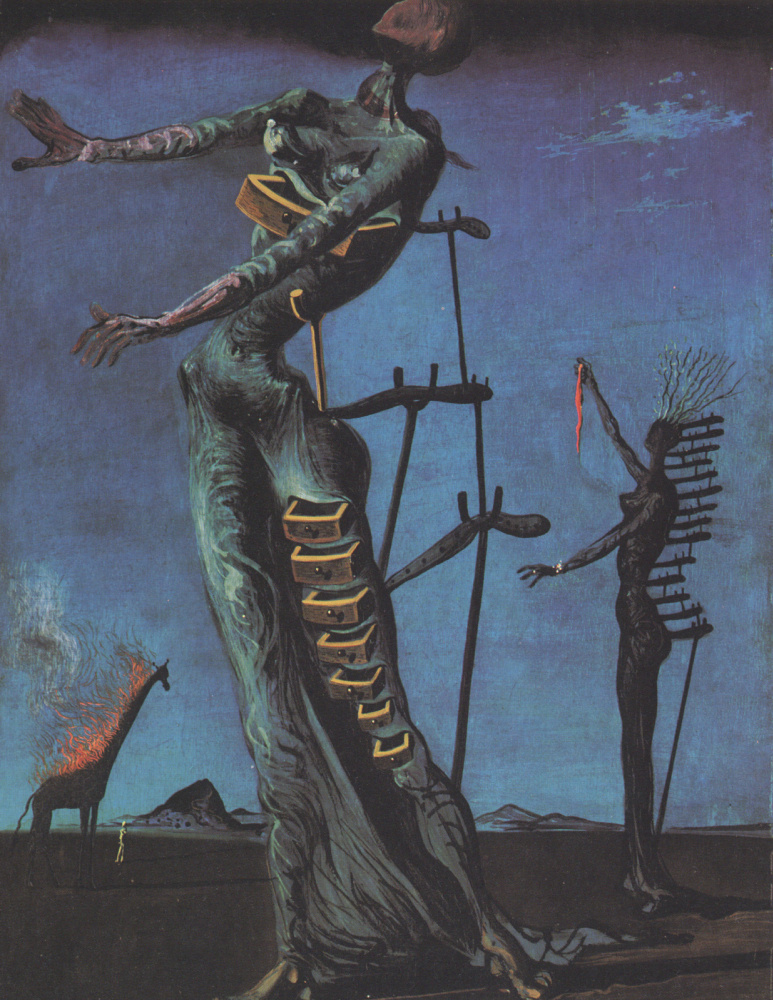log in
Enter site
Login to use Arthive functionality to the maximum
Giraffe on fire
Salvador Dali • Painting, 1937, 35×27 cm
Description of the artwork «Giraffe on fire»
"Giraffe on Fire" is one of the most famous paintings by Salvador Dali, combining several of the artist's favorite images. The central figure - a woman with drawers on her body - was first revealed to the world in 1936 in the form of a sculpture “Venus de Milo with boxes". A similar image (the artist called it an "anthropomorphic wardrobe") appeared in various modifications in several more works by Dali (1, 2). Drawers, as in this case, are always shown open. Their significance has several interpretations: from the symbol of the psychoanalytic process to “unintentional search”, according to the artist himself.
Dalí also mentions a similar metaphor, saying that his paintings form "a kind of allegory that serves to illustrate a certain insight to follow the many narcissistic scents that emanate from each of our boxes." In addition to this furniture accessory, the female figure has a number of other expressive features: behind it are several sluggish processes that need support with crutches. They can hint at problems with potency, which Dali was never shy about and often mentioned about them.
The woman's hands look like they have been skinned. Her face is completely covered with hair and she stretches her arms forward, as if she is trying to grope her way in complete darkness. And the female figure behind her is even less human. The back of her body is almost completely covered with strange appendages, making her look like a porcupine, thin branches stick out from her head, and a piece of flesh hangs from her arm.
All this phantasmagoria is complemented by a giraffe with a flaming back and an alarming dark sky. These two symbols are traditionally attributed to the fear that Dali experienced in connection with the Spanish Civil War during the creation of the painting "Giraffe on Fire". In other interpretations, the work is considered the embodiment of a premonition of the Second World War. The artist himself called the exotic animal "a male cosmic apocalyptic monster."
The first time a burning giraffe appeared in Luis Buñuel's film "The Golden Age" (1930), in the credits of which Dali is listed as a co-author of the script. In addition to "Giraffe on Fire", this image has repeatedly floated in his paintings, such as "Creation of monsters"(1937),"Flaming giraffe"(1937) and"Burning giraffes and phones"(1937).
Be that as it may, this picture became one of the first among several dozen trulygloomy and evensinister works of the Spanish artist with frightening images that he will create over the next few years. And Dali's horror before the hostilities was really so great that he chose to hide from them, crossing the whole ocean. Beginning in 1940, he and Gala settled in the United States and returned to Spain only eight years later, when peace was finally restored in Europe.
The author: Natalia Azarenko
Dalí also mentions a similar metaphor, saying that his paintings form "a kind of allegory that serves to illustrate a certain insight to follow the many narcissistic scents that emanate from each of our boxes." In addition to this furniture accessory, the female figure has a number of other expressive features: behind it are several sluggish processes that need support with crutches. They can hint at problems with potency, which Dali was never shy about and often mentioned about them.
The woman's hands look like they have been skinned. Her face is completely covered with hair and she stretches her arms forward, as if she is trying to grope her way in complete darkness. And the female figure behind her is even less human. The back of her body is almost completely covered with strange appendages, making her look like a porcupine, thin branches stick out from her head, and a piece of flesh hangs from her arm.
All this phantasmagoria is complemented by a giraffe with a flaming back and an alarming dark sky. These two symbols are traditionally attributed to the fear that Dali experienced in connection with the Spanish Civil War during the creation of the painting "Giraffe on Fire". In other interpretations, the work is considered the embodiment of a premonition of the Second World War. The artist himself called the exotic animal "a male cosmic apocalyptic monster."
The first time a burning giraffe appeared in Luis Buñuel's film "The Golden Age" (1930), in the credits of which Dali is listed as a co-author of the script. In addition to "Giraffe on Fire", this image has repeatedly floated in his paintings, such as "Creation of monsters"(1937),"Flaming giraffe"(1937) and"Burning giraffes and phones"(1937).
Be that as it may, this picture became one of the first among several dozen trulygloomy and evensinister works of the Spanish artist with frightening images that he will create over the next few years. And Dali's horror before the hostilities was really so great that he chose to hide from them, crossing the whole ocean. Beginning in 1940, he and Gala settled in the United States and returned to Spain only eight years later, when peace was finally restored in Europe.
The author: Natalia Azarenko


